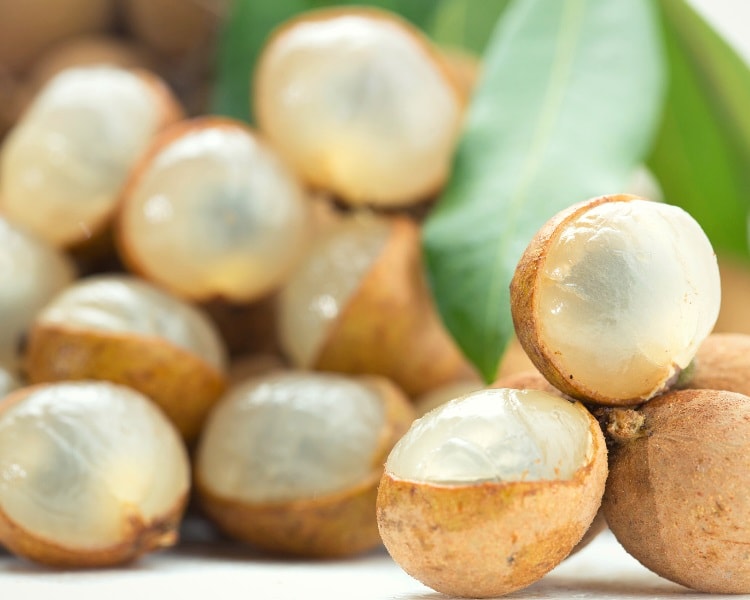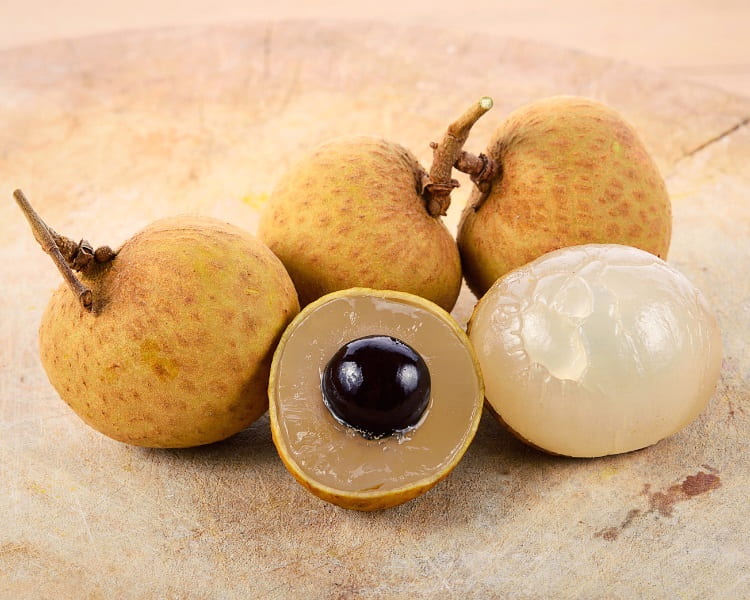Last updated: March 20, 2024
In the latest installment of my never-ending quest to find different exotic fruits and excitingly unique vegetables, I am now going to discuss the longan fruit.
Longan fruit is a small tropical fruit with delicious, soft white flesh. It’s not always easy to find, but wow, do they taste good!
In this article, I am going to share with you everything I’ve learned about the exotic longan, its origins, nutritional profile, and potential benefits.
What Is a Longan Fruit?
The longan, also called Dimocarpus Longan, is a tropical fruit tree that is native to tropical Asia and China. Longan is related to the rambutan fruit and the lychee.
The tree is now grown in different parts of Southeast Asia, like India, Vietnam, Indonesia, Taiwan, Sri Lanka, and Thailand. The Dimocarpus Longan tree is said to produce around 50,000 longan fruits per year.
In China, the Longan is also referred to as Dragon’s Eye and is used in traditional Chinese medicine. They’ve used it for centuries to help with sleep problems, ease digestion, and as a natural relaxant. Some people even believe that eating the fruit can make you look more beautiful!

The longan fruit is used in various different ways in Asian countries. In Chinese herbal medicine, they use the dried leaves or flowers. In Taiwan, the flower is turned into an infusion for tea. The seed has also been used as an ingredient in shampoo.
Clearly, it’s considered quite a versatile fruit in large parts of Asia.
How to Eat Longan Fruit?
How do you eat a longan fruit? It’s very similar to how you would eat a lychee, which you are probably more familiar with.

It’s nothing too complicated. Simply peel off the skin, and eat the transparent, white-colored flesh that you will see on the inside.
What Does Longan Fruit Taste Like?
As you may have guessed by now, longans can be a little sweet, but in their own unique way. It’s definitely not too sweet, which is one of the reasons I love this fruit so much.
The flesh is very juicy, which is no surprise since longan fruit has a high water content. That juiciness, though, makes this tropical fruit even more enjoyable to eat.
What About the Seeds?
It’s the big black seed in the middle of a longan fruit that has earned this fruit its exciting nickname, dragon’s fruit. The fruit does resemble an eyeball, with the black seed inside being the pupil.

Interestingly enough, it’s that very same seed that actually holds a lot of polyphenols, which are micronutrients that are packed with antioxidants.
This is one of the reasons why the longan fruit seed has long been used to prepare traditional remedies, but otherwise, you wouldn’t want to eat the seed with the flesh.
Where to Buy Longan?
Sadly, as common as longans are in various Asian countries, they’re not so easy to find in the rest of the world. But you may be able to get your hands on them if you go to specialty or Asian grocery stores.
Because fresh longan fruit is so hard to find in Western countries, we do regularly see canned or dried longan available in grocery stores.
The problem with these preserved types of longan fruit is that they typically contain a lot more sugar than fresh or frozen longan fruit, and therefore, I wouldn’t recommend buying the canned or dried version.
Plus, fresh longan fruit simply tastes the best, and it’s the fresh flavors that make this fruit so delicious.
Nutritional Profile and Benefits
I went to the USDA FoodData Central website to look at the nutritional profile of longan fruit, and I’ve listed the most interesting one in the table below.
As you can see, longan fruit is certainly not the most nutritious fruit out there, but it does have some interesting numbers for certain nutrients.

In short, longan fruit is reasonably low in calories, contains almost no fat, offers a good amount of vitamin B2, potassium, and copper, and is very rich in vitamin C.
It’s also worth mentioning that longan fruit, unlike most other fruits, is relatively low in fiber. On the other hand, longan fruit is quite high in carbohydrates compared to some other fruits.
| Longan Fruit Nutritional Profile (100g raw) | |
|---|---|
| Water | 82.75 g |
| Energy | 60 kcal |
| Protein | 1.31 g |
| Fat | 0.1 g |
| Carbohydrates | 15.14 g |
| >> Dietary fiber | 1.1 g |
| Minerals | |
| Copper | 0.169 mg (8% DV) |
| Iron | 0.13 mg (1% DV) |
| Magnesium | 10 mg (2% DV) |
| Manganese | 0.052 mg (3% DV) |
| Phosphorus | 21 mg (2% DV) |
| Potassium | 266 mg (8% DV) |
| Vitamins | |
| Vitamin B1 (Thiamin) | 0.031 mg (2% DV) |
| Vitamin B2 (Riboflavin) | 0.14 mg (8% DV) |
| Vitamin B3 (Niacin) | 0.3 mg (1% DV) |
| Vitamin C | 84.0 mg (140%) |
| Source: USDA | |
Benefits
Let’s take a closer look at what we can expect from longan fruit, apart from the delicious taste.
1. Source of Vitamin C
While Longan fruit may not be the most nutrient-dense fruit in the world, there’s no denying that this little treat is an excellent source of vitamin C.
As shown in the table above, 100 grams of fresh and raw longan fruit contains approximately 84 mg of vitamin C, which is 140% of the recommended daily intake.
Vitamin C is an antioxidant and as such, is an essential nutrient for humans. Antioxidants can counteract oxidative stress, and thereby help prevent cell damage and fight off disease.
2. Source of Copper
Copper is an important mineral that plays a role in many of the body’s organs and systems. To name a few, copper makes red blood cells, keeps nerve cells healthy, protects cells from damage, and supports our immune system.

Longans contain a good amount of copper, around 0.17 mg per 100 grams, which equates to more than 8% of the recommended daily intake.
3. Source of Potassium
The longan fruit also offers a noticeable amount of potassium, an essential mineral that helps regulate fluid balance, nerve signals, and muscle contractions.
One hundred grams worth of longans provides 266 mg of potassium, which equates to 8% of the recommended daily intake.
Final Thoughts
As you can tell by now, I love eating longans because of the flavors and the soft texture of the flesh. It may not be the most nutrient-rich food in the world, but that doesn’t remove the fact that it’s still a healthy treat.
They’re hard to find, but I love going out of my way to discover more unusual fruits and unique vegetables. It’s a lot of fun, and I can learn so much about these foods as I find and eat them.
Here are some more exciting tropical fruits I’ve discovered:

